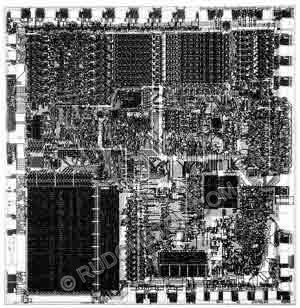Names and short parametres of processors. A part 1.
Evgenie Rudometov, Victor Rudometov.
authors@rudometov.com
Article is grounded on substances of books "Arrangement of the multimedia computer" and "Motherboards and chip sets"
For three ten years of intensive perfection of processors the large quantity of these extremely important units which differ as solid-state technology, by the architecture and konstruktivom, and the price, and functionality, including productivity has been released. Not only new, but also many of early models are successfully maintained as a part of the computers which are now for users. Thus quite often in the technical literature and instructions use not only firm trading names of processors, but internal names of these products and their architectures that complicates identification of products.
To attempt of classification of names of processors and their architectures with coercion of key parametres the substances presented more low are resulted.
(A part 1, Intel: from the first processor to P5)
From time of release by the corporation of Intel of the first-ever processor has transited hardly more than three tens years. For this time the given corporation inspecting, by the way, already more of 80 % of the market of processors, it has been released hundred millions these extremely important units. Thus they had different architectures, types and names. Some data of the released products of Intel will be resulted further.
The note
Despite a high-scale of reliability of used sources, in the resulted data separate inaccuracies can contain.
i4004
(On November, 15th 1971 ) — working assembly frequency 108 kgts, 0,06 million operations a second, 2 300 transistors, processing technique 10 microns, the bus of 4 bits, the addressed memory of 640 byte. Was the first-ever computer chip used for arithmetic calculations. It was applied in calculators Busicom.
Fig. 1. The First-ever processor (Intel 4004)

Fig. 2. A processor kernel i4004
i8008 (April 1972 ) — clock rate 200 kgts, 0,06 million operations a second, 3 500 transistors, processing technique 10 microns. The bus of 8 bits, the addressed memory of 16 Kbytes. Following after 4004 processor. It was developed simultaneously with the processor 4004. The Basic purpose — data processing and the text. It was applied in dumb terminals, general purpose calculators, automatic machines of bottle flood.
i8080 (April, 1974 ) — clock rate of 2 MHz, 0,64 million operations a second, 6 000 transistors, processing technique 6 microns, the bus of 8 bits, the addressed memory of 64 Kbytes. In comparison with the processor 8008, productivity has increased ten times, and the quantity of chips of support has decreased with 20 to six. The processor was applied in automation arrangements, and also in computers Altair (Altair computer — the first PCs).
i8085 (March, 1976) — working clock rate of 5 MHz, 0,37 million operations a second, 6 500 transistors, processing technique 3 microns, the bus of 8 bits. For the first time the uniform power supply 5 In (earlier - 12 volt) is applied . Used in trading automatic machines and electronic scales.
i8086 (On June, 8th, 1978) — working clock rate of 4,77-10 MHz; 0,33 million (4,77 MHz), 0,66 million (8 MHz), 0,75 million (10 MHz) operations in a second; 29 thousand transistors, processing technique 3 microns, internal digit capacity of 16 bits, the external data bus of 16 bits, the bus of 20 address of bats, address space of 1 Mb. In comparison with i8080 productivity has increased in 10 times. The processor i8086 used in PC PC/XT. The special chip was applied To hardware performance of some special mathematical operations together with the processor i8088 — the math coprocessor i8087.
i8088
(June, 1979) — modification i8086; working clock rate of 4,77-8 MHz, 0,75 million (8 MHz) operations in second, 29 thousand transistors, processing technique 3 microns internal digit capacity of 16 bits, but the external data bus of 8 bits (transmission of 16-bit data — for two clock ticks), that provided possibility of hooking up of controllers, before developed for 8-bit computers; the bus of 20 address of bats, address space of 1 Mb. The processor i8088 widely used in PC PC/XT. The math coprocessor was applied To hardware performance of some mathematical operations together with the processor i8088 i8087.
Fig. 3. A processor kernel i8088
i80186 (1982) It was applied in arrangements and management systems.
i80286 (February, 1982) — working clock rate of 6-12 MHz, 0,9-2,66 million operations second, 134 thousand transistors, the processing technique 1,5 microns, internal digit capacity of 16 bits, the external data bus of 16 bits, the bus of 24 address of bats, address space of 16 Mb, the virtual storage of 1 Gbytes, is possible operation in a protected mode. In comparison with the processor i8086, productivity has increased in 3-6 times. It was applied in PC PC/AT-286 (it is released in 1984), together with i80286 the math coprocessor i80287 used.

Fig. 4. A processor kernel i80286
i80386DX (On October, 17th, 1985) — working clock rate of 16-33 MHz. The processor with frequency provided of 16 MHz from 5 to 6 million operations second, 20 MHz — 6 to 7 million op/with, 25 MHz — 8,5 million op/with, 33 MHz — 11,4 million op/with. Incorporated 275 thousand transistors, processing technique 1,5 microns and 1 micron, internal digit capacity of 32 bits, the external data bus of 32 bits, the bus of 32 address of bats, address space of 4 Gbytes, the virtual storage of 64 Tbyte. Uses in PC PC/AT-386 and PS/2, modifications SX with the 16-bit data bus and SL, SLC with reduced energopotrebleniem for application in laptops of type Notebook are released, together with the processor i80386 the math coprocessor i80387 used.

Fig. 5. A processor kernel i80386
To pass to razrelu Processors
 English
English Russian
Russian German
German